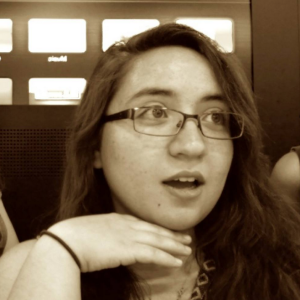David White: Your story, “Sitting in the Sandbox”, is fictional, but draws on a sense of realism. What is it about the nitty-gritties of reality that speak to you? What is the distinctive appeal of a true-to-life fictional story?
Eva Marino: What truly draws me to the nitty-gritty stuff is how people respond to it. But what I really admire is the human spirit (as cheesy as that sounds), and it amazes me what a human can endure. A person can survive about three weeks without food, or he or she can endure years of ridicule or domestic abuse. In the end, after enduring such torment, some people still have the ability to be optimistic or kind, instead of the opposite. This strength is what attracts me to true-to-life stories because I find it easier to connect to characters who struggle with faults and obstacles, and I like to see them push though and strengthen themselves along the way.
DW: Besides being a talented writer, you’re an award winning artist; how do you feel your art and your writing intersect? And when you feel creative, how do you choose whether to paint or write?
EM: Well, I have the tendency to daydream a lot, and I mostly daydream about the little details in life. For instance, I could be looking at a desert sunset and admire how brilliantly the colors blend in the sky or how they hit the curves of the clouds. Not only do I like putting these little details on a canvas, but I love how words can act as paint, also. I guess my attention to detail is what intersects both mediums, and it’s something I’m really careful about when it comes to any form of art.
When it comes to painting versus writing, I guess it depends on what I want to capture. In my paintings, I usually want to try to capture the colors or expressions that words can’t really explain, and I usually leave the interpretation to the viewer. In my writing, I want to be more specific about a scene, and I want to make it active. It’s kind of like saying my paintings are made to capture a moment, and my writings are made to capture a series of events.
DW: The story is told in first person. How do you make the decision to use a first-person narrator rather than a removed narrator?
EM: In the case of “Sitting in the Sandbox,” the topic of the story was very personal to me, and I’ve gone through a similar conversation with a close friend of mine, so I felt that first person was appropriate because it was like I am personally telling the story. For me, first-person narratives are easier to use when trying to make a closer connection with the reader, as opposed to a removed narrator, who doesn’t really have an emotional connection to the story. I know many great writers are successful in making an emotional connection through removed narrations, but I’m not quite good at it yet.
DW: r.kv.r.y’s focus is on recovery, on “obtaining usable substances from unusable sources.” What are your characters trying recover? What are their “unusable sources” and how do they obtain “usable substances”?
EM: My characters are just average teenage girls, but one of them, Dhalia, is met with the issue of not being accepted as she is, and the narrator is trying to be the light in her friend’s dark world. Dhalia is trying to recover her sense of self because she is afraid of her family’s rejection, and the narrator is trying to recover the best friend that she is slowly losing to self-loathing.
Their “unusable sources” are the situations in which they have found themselves in: a young girl fearing ridicule and rejection because of who she is, and a best friend in pain. Out of these sources, both of them obtain friendship, love, and compassion. Dhalia finds a friend who she knows will love her for everything that she is, and who will comfort her when she is in pain, and the narrator finds a friend who trusts her completely. The two girls know they can share anything with each other, and I think is really important in any healthy relationship.
DW: “Sitting in the Sandbox” alludes to a time of innocence, a time of childhood, and yet, your characters are verging on adulthood. Could you explain your symbolism here? Why a sandbox, which is associated with the playground?
EM: Well, most teens struggle with people telling them to act more mature, but they are still not treated as adults, and this constant wavering between childhood and adulthood can be dizzying. In all honesty, there are many children and teens in this world that deal with adult problems, and they are not quite sure how to deal with them. Dhalia, a teenager, is struggling with her identity, as most teens do, and she is unsure of how to handle the situation. Although I am new to being an adult, I think I can safely say that many adults still go through this struggle with finding themselves. This inner struggle, along with other adult issues (e.g. taxes, jobs, health, money, etc.) can make someone wish they were back in elementary school, playing in a sandbox and not having to care about the nitty-gritties of the world.
So, the symbolism of the sandbox is the girls’ wish to stay young and innocent. The girls don’t want to deal with stressful conflicts, expectations, and responsibilities, but their fate is inevitable. By being on the playground, they are trying to hang on to what innocence they have left before they are thrust into adulthood.
David White teaches Creative Writing to high school students.



Pingback: Sitting in the Sandbox | Rkvry Quarterly Literary Journal